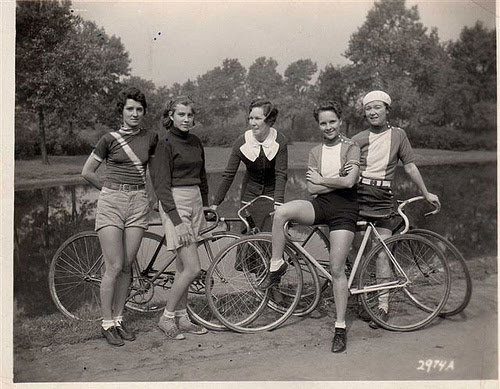Why are Bicycle Frames Still Gendered Objects? By Hanna Negami
|
To mount the first bicycle, invented in 1817 by Karl von Drais, one needed to swing a leg over the top beam, a practice considered too un-ladylike for women; the seated position was also difficult to maintain while wearing a long skirt (Oddy 60-61). In 1819, the first prototype for a woman’s frame was invented by Denis Johnston, setting an “important precedent”: the female frames were based on a “male theme,” rather than having their own design, and so far this practice has “never been challenged” (Oddy 61).
Today, diamond and step-through frames are still referred to as “men’s” and “women’s” frames, respectively, even though people of both genders ride bicycles of either frame (but women are probably more likely than men to ride a frame that is “meant” for the other gender – more on this later). The gendered distinction between frame styles is no longer relevant, as women must no longer wear long skirts (thanks, Amelia Bloomer!).
Why, then, are bicycle frames still gendered objects? In his essay “Bicycles” in the anthology The Gendered Object, Nicholas Oddy writes that the preservation of socially-constructed gender classification of bicycles “can only be accounted for in terms of ‘tradition’” (66), and that contemporary bicycle designers have “sustain[ed] gender classifications” through different aesthetic presentations of bicycles to men and women (66).
Is tradition or collective memory really the only reason this gender classification still exists today? Gendering an object places it within a power structure; because diamond frames are faster and more perhaps more rigid than step-through frames, it is likely that the perpetuation of gendering bicycle frames has something to do with a white-knuckled male grip on power and dominance. Indeed, when bicycle frames for women became popular in the 1890’s, “they were a male design compromised by social conditions and were seen as lesser machines than their male counterparts” (Oddy 67). This gender hierarchy accounts for why it’s more socially acceptable for women to ride men’s frames than vice versa. Furthermore, who’s to say the top tube being “male” isn’t something symbolic?? I mean, what’s more male than having something tubular sticking out between your legs?
Susan B. Anthony said that the bicycle “has done more to emancipate women than anything else in the world,” that “it gives a woman a feeling of freedom and self-reliance.” While the bicycle should be celebrated for historically giving greater physical and social mobility to women, it should also be recognized as a means of maintaining patriarchal values. Both diamond and step-through frames have their own advantages, and step-through frames are widely used in bike-friendly cities like Amsterdam and Copenhagen; still, the vestigial gendering of these frames and other quotidian objects reflects and reinforces yet-entrenched sexism.
Works Cited Oddy, Nicholas. “Bicycles.” The Gendered Object. Ed. Pat Kirkham. Manchester: Manchester University Press, 1996. 60-69. |
